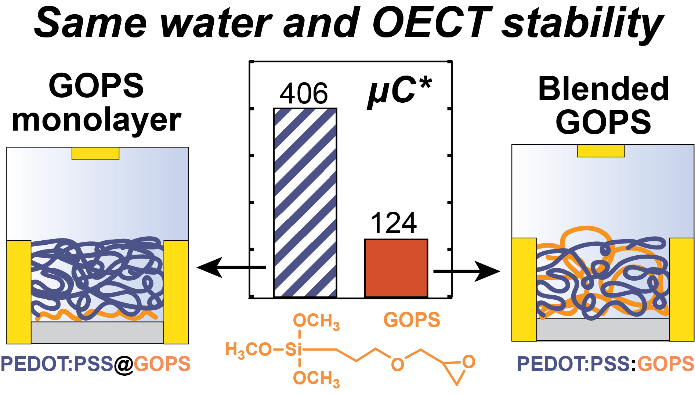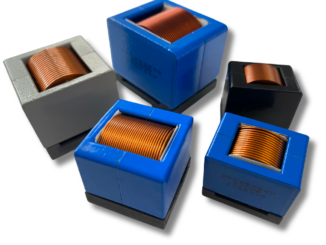
In the ever-evolving field of materials science, the quest for improving the stability and performance of organic semiconductors has become increasingly crucial. The instability of organic semiconductors can lead to performance degradation in devices like organic photovoltaic cells, organic light-emitting diodes (OLEDs), and flexible electronics. The challenge has been to find effective strategies to enhance the material’s stability without compromising its desirable electrical properties. The work by researchers from the University of Delaware sheds light on an innovative approach to enhancing the aqueous stability and electronic performance of poly(3,4-ethylenedioxythiophene) polystyrene sulfonate (PEDOT:PSS) thin films, a popular material in the electronics community due to its high conductivity, transparency, and ease of processing.
Among their discoveries, the team has identified surface modification of the substrate with (3-Glycidyloxypropyl)trimethoxysilane (GOPS) to introduce a silane monolayer with epoxy groups before spin-coating the PEDOT:PSS dispersion on the substrate to achieve enhanced stability without compromising the performance. GOPS is a silane compound known for its ability to form strong covalent bonds with hydroxyl groups present on the surface of substrates. By applying GOPS to the surface of the substrate, the researchers aimed to create a more robust barrier against moisture, thereby enhancing the material’s overall stability. This functionalization technique differs from traditional methods that typically require blending with other polymers or additives which impacts the morphology and thus electrical properties of the PEDOT:PSS films. While the study focused on PEDOT:PSS on various substrates (glass, silicon wafer, gold), the same functionalization method could be extended to other organic semiconductors containing nucleophilic substituents that can react with epoxides, such as carboxyl and amine functional groups, to reduce substrate delamination and maintain material performance for a range of applications.
To investigate the potential application in bioelectronic devices, the researchers used the surface-functionalization method to fabricate organic electrochemical transistors (OECT). The figure-of-merit that measures the effective signal amplification of an OECT is the transconductance, and the surface functionalization approach led to higher transconductance in the OECT devices. The OECT devices also showed good long-term performance under several stress conditions which validate the suitability of the surface-functionalization method for practical applications.
The results are reported in ACS Applied Materials and Interfaces.
“Aqueous stability is crucial for the long-term performance of electronic devices, especially those exposed to humidity and moisture, such as wearable technology and outdoor solar panels. Organic semiconductors are often susceptible to degradation when exposed to water, which can lead to a decrease in electrical performance, loss of mechanical integrity, and ultimately, device failure. Therefore, improving the stability of these materials in water is not just a scientific challenge; it is a prerequisite for commercial viability,” says Peter Odion Osazuwa, graduate research assistant in the Department of Materials Science and Engineering and leader of the work.
Peter Osazuwa’s colleagues on the work include Chun-Yuan Lo, Abigail Nolin, Dr. Xu Feng, Dr. Charles Dhong, and Dr. Laure V. Kayser who is the corresponding author of the work.
Implications for the Future of Organic Electronics
The implications of Osazuwa’s work extend far beyond just enhancing the properties of PEDOT:PSS. By demonstrating the effectiveness of surface functionalization with GOPS, the study opens new avenues for the development of more stable and high-performing organic semiconductor materials. For example, in solar cells, greater stability can lead to higher efficiency and longevity, which are critical for commercial applications. Similarly, in OLEDs, improved water resistance translates to better brightness and color accuracy over time.
Moreover, Osazuwa’s findings have broader implications for the field of organic electronics. By addressing stability issues, his research helps to mitigate one of the major concerns that manufacturers face when scaling up production. The ability to produce robust, stable organic semiconductors could lead to a new wave of innovation in flexible and wearable technologies, making them more reliable and accessible to consumers.
Bridging Research and Industry
The innovative findings of this study hold significant promise for bridging the gap between research and practical application. As industries increasingly seek materials that offer both performance and durability, the techniques and insights gained from this research could be transformative.
By demonstrating that surface modification can enhance the properties of PEDOT:PSS, the study paves the way for a new paradigm in materials engineering. Researchers and manufacturers can adopt these strategies to tailor the properties of organic semiconductors, leading to advancements in technology that were previously thought unattainable.
By Asishana Onifevu
Department of Chemistry, University of Delaware



